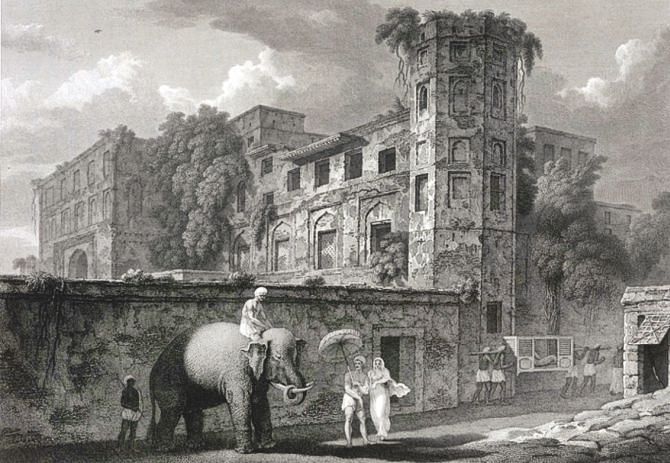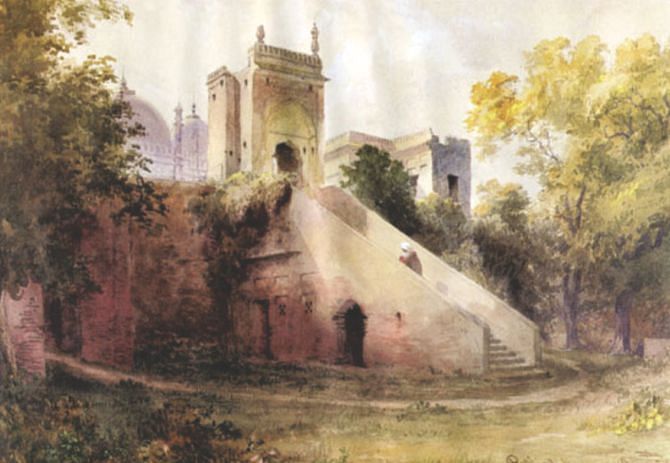Dhaka on Europeans' canvas
Dhaka on Europeans' canvas
19th century paintings by noted artists

In 1808, Charles D'Oyly, Collector of Dhaka, wrote to Warren Hastings, “I shall offer you as companions, a few of the ruins of the city of Dacca which are exquisite for their magnificent elegance …”
About a hundred years of British rule by the East India Company saw many European painters finding their way to India. Beckoned by the charm of the orient, artists sketched details of the everyday lives of the natives, buildings, landscapes and festivals.
While English painters had to struggle for a living in their home in England, these Western painters were able make a living in the orient. Their newfound affluence led to a stream of artists in the eighteenth to the nineteenth century. These painters had the patronage of either Rajas or Nawabs. While they mostly did portraits, they did not ignore the inhabitants of the land or the landscape. Thus buildings and surroundings crept into the paintings.
Of the painters who came to Dhaka, the best known is Charles D'Oyly. Francesco Renaldi and Robert Home also spent much time in Dhaka. One of the most important paintings on Lalbagh Fort can be traced to colonial times. Great care is given to the gate, painted stray dogs, fruit sellers and passers-by. He recorded details of everyday life. He did sketches of the Third Mysore War and settled down in Calcutta (now Kolkata) for the next 20 years, making his living as a portrait painter. George Chinnery and D'Oyly together explored and sketched the ruins of Dhaka. In D'Oyly's “Antiquities of Dhaka”, he made records of buildings, riverscapes and landmarks of the city. He served the East India Company for 40 years. Chinnery earned well but he blew it up as fast as he got it. Of his known works in oils are Pagla Pool and the Boro Katara.
Arthur Lloyd Clay was another artist who flourished in those times. William Alexander De Fabeck's paintings of 1863 are preserved in the Victoria and Albert Museum. De Faback studied in Paris. He joined Bengal Service as an assistant surgeon. A painting of Neemtola Gate is an important record of the structure. John Scott Phillips did 46 sketches during his trip to the Sunderbans and Dhaka. His sketch of the late afternoon Ramna Park with the temple and the priest's hut was destroyed later by the Pakistan occupation army. Molesworth joined the Royal Navy as a cadet. He noted down his experiences in a diary. This contained drawings and illustrations of Fulbaria, Mirpur, Savar and the Tongi Bridge. Dhaka's first private school, the Pogose School, was built by the Armenians who came to trade in Bengal. Charles Pote made two pieces for the school. Much of the work is now missing. Charles' father, Edward Pote, lived in Patna, Bihar. Charles studied in Kolkata and later worked in London.
Colonial art was a subject of three London weeklies which carried the news of the Empire and its colonies. The Illustrated Times carried Lalbagh Fort, Nawab Bari, and Meghna outskirts.

The original works by Europeans are not in the country any more. People have little opportunity to enjoy the depiction of Dhaka's rich ancestry.
Lalbagh Fort by Charles D'Oyly (1816) Antiquities of Dhaka -- has wild shrubs growing over the structure, while men, women and a cow sit or stand on the banks. The Remain of the Bridge near the Tantee Bazaar by D'Oyly has trees, people and Lotus flowers on the river, ground and on top of the bridge. The scenes are idyllic and romantic. His “Pagla Pool” and “On the Dholai Khal” are both beautiful and noteworthy for their historical importance. Judge Sherman is seen with an Indian Secretary, by George Chinnary in oil. De Fabeck's depictions of the “River Buriganga” and a “Ruined mosque” by D'Oyly are magnificent. Both are from the Victoria and Albert Museum. The leaves of the trees and the minaret's of the mosques are done in minute details. The roofs of the houses are architecturally accurate in lines and forms. The lemon and earthy colours of the foliage are bewitching. The “Great Kuttra” and the “Small Kuttra” by the same painter are fascinating too for their accuracy.
Hunting scene with elephants and horse by Arthur Lloyd Clay and his Dhaka Jail Inspection, 1896, are indeed moving in the accuracy of the details.